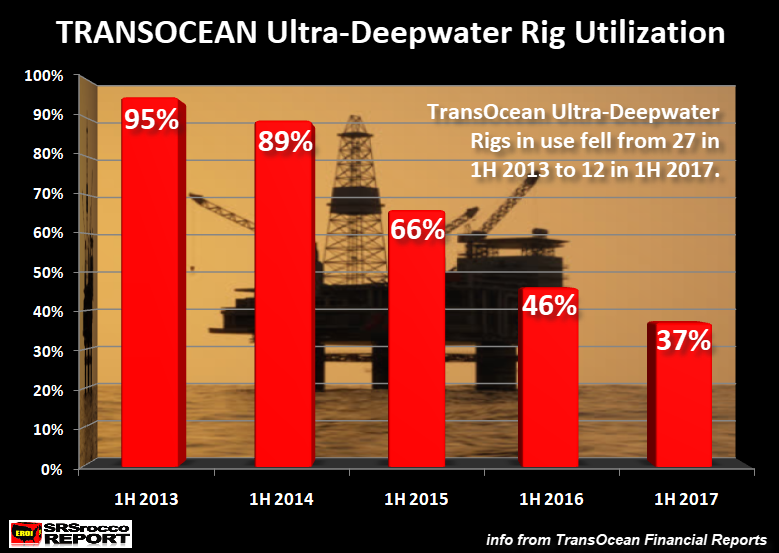
By the SRSrocco Report,
The U.S. Deepwater Offshore Oil Industry is a trainwreck in the making. The low oil price continues to sack an industry which was booming just a few short years ago. The days of spending billions of dollars to find and produce some of the most technically challenging deep-water oil deposits may be coming to an end sooner then the market realizes.
Drilling activity in the Gulf of Mexico hit a peak in 2013 when the price of oil was over $100 a barrel. However, the current number of rigs drilling in the Gulf of Mexico has fallen to only 37% of what it was in 2013. This is undoubtedly bad news for an industry that fetches upward of $600,000 a day for leasing these massive ultra-deepwater rigs.
One of the largest offshore drilling rig companies in the world is Transocean, headquartered in Switzerland. They lease ultra-deepwater rigs all over the globe. When the industry was still strong in 2014, nearly half of Transocean's fleet of 27 ultra-deepwater rigs were leased in the Gulf of Mexico. Even though Transocean was quite busy that year, its ultra-deepwater rig utilization was 89% during the first half of 2014, down from an impressive 95% in 1H 2013.
The term utilization represents the total number of working rigs in the fleet. So, in 2013, Transocean had 95% of its rigs busy drilling oil wells. But if we look at the following chart, we can see the disaster that has taken place at Transocean since the oil price fell by more than 50%:
Currently, Transocean's ultra-deepwater rig count has dropped to a low of 12 versus 27 in 2014. And it's even worse than that. Since 2014, Transocean added three more new rigs for a total number of 30. Thus, Transocean's ultra-deepwater rig utilization is down to a stunning 37% compared to 95% just four years ago. So, when a rig isn't working, it's not making revenue.
The loss of revenue from these ultra-deepwater drilling rigs seriously hurts the company's bottom line. According to Transocean's Q2 2017 Report, they lost $1.7 billion in one quarter. However, the majority of that loss was due to a large asset disposal. Regardless, even if we go by adjusted income and remove the large disposal writeoff, Transocean still only made a whopping $1 million adjusted profit on total revenues of $1.5 billion.
To give you an idea of the size of one of Transocean's rigs lets takes a look at its Sedco Express ultra-deepwater drilling platform.
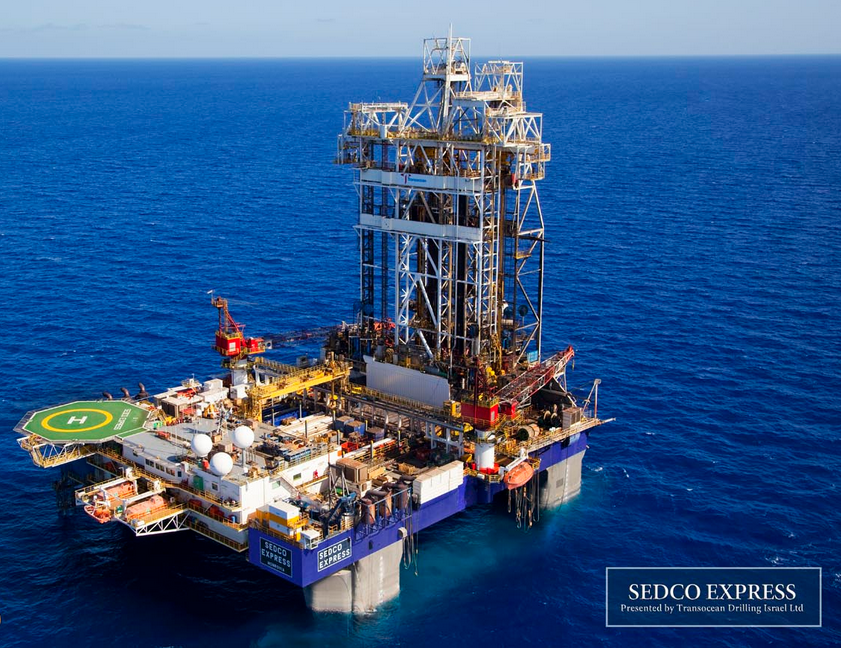 The Sedco Express deepwater is semi-submersible that is longer than a football field (364 ft) and weighs 38,000 tons when operating. The Sedco Express rig has a crew of 184 people and can drill a well 35,000 feet deep. When these large rigs were in high demand; they were contracted to drill oil and gas wells all over the world.
The Sedco Express deepwater is semi-submersible that is longer than a football field (364 ft) and weighs 38,000 tons when operating. The Sedco Express rig has a crew of 184 people and can drill a well 35,000 feet deep. When these large rigs were in high demand; they were contracted to drill oil and gas wells all over the world.
For example, the Sedco Express was hired by Erin Energy Corp (formerly Camac) to drill oil wells off the coast of Nigeria. Transocean received $300,000 a day for leasing Sedco Express to drill these wells. At nearly a $10 million a month, it doesn't take long for these rigs to earn some serious revenue.
Unfortunately for Sedco Express, its drilling days are numbered. How numbered? Actually, its drilling days are over for good. Why? Because Sedco Express is now being sent to the junkyard to be "environmentally scrapped."
You see, Sedco Express is an older rig that is no longer useful or commercially viable, especially in the depressed ultra-deepwater drilling industry. As I stated above, Sedco Express did receive that $300,000 per day to drill oil wells off the Nigerian coast, but that was back in 2014. If we take a look at Transocean's Fleet Status Report, we can see Sedco Express at the bottom:
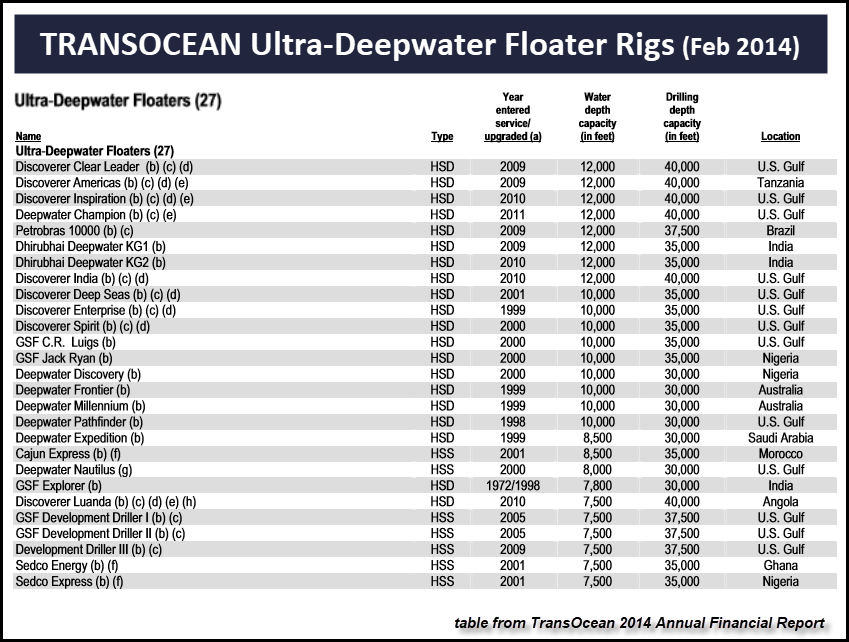
Here we can see that Sedco Express entered service in 2001. Thus, Sedco Express is only 16 years old. Again, if we look at the list above, Transocean had most of its rigs in service at the beginning of 2014. Furthermore, half of the rigs were leased in the U.S. Gulf of Mexico. Now, let's look at a more recent Transocean Fleet Status Report:
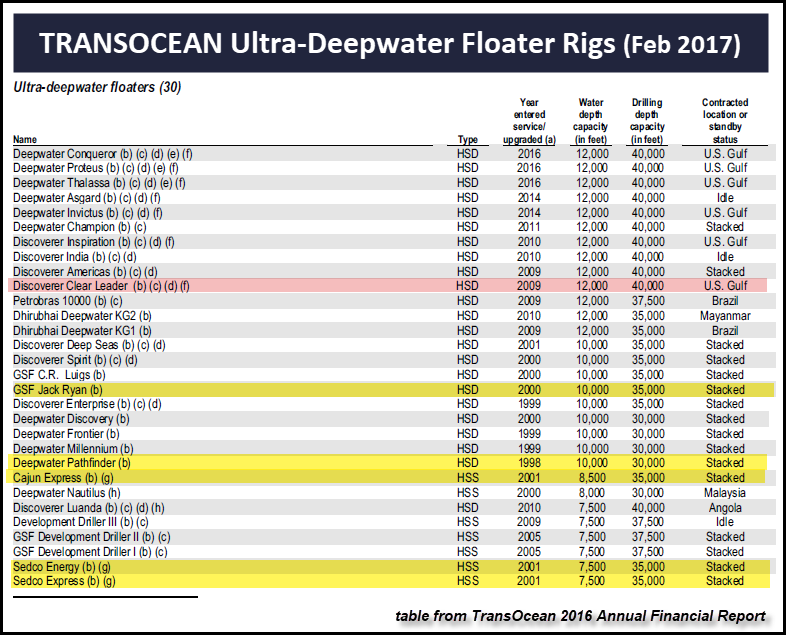
Please notice the number of STACKED rigs on the list (right-hand side of the table). Transocean now has 11 rigs working, 16 stacked and 3 idled. However, the rigs highlighted in yellow represent the rigs heading to the junkyard. Transocean is junking these 5 ultra-deepwater rigs plus another deepwater rig called the Transocean Marianas. Instead of paying the $40,000 a day to warm stack or $15,000 a day to smart stack these rigs, Transocean decided it was a better financial decision just to remove them from their fleet. I would imagine if Transocean believed the price of oil would recover to $80-$100 quickly, they might have held off this decision.
Unfortunately, mainstream energy analysts do not believe the ultra-deepwater rig industry will recover until at least 2020 or more realistically by 2024. While the mainstream energy analysts believe the ultra-deepwater drilling rig industry will improve within the next 6-7 years, I don't think it will ever recover. Rather, I see a continued disintegration of this HIGH COST, LOW EROI energy industry (EROI - Energy Returned On Investment).
Before we get into the final part of the article, I wanted to explain the highlighted RED rig. The Discoverer Clear Leader rig leased to Chevron was contracted to end in October 2018. However, Chevron recently announced an early termination of that contract to end in November 2017. Chevron will pay Transocean $148 million for contract termination fees. When this was published in the media, Transocean's stock fell 5% that day. Lastly, at its peak of 95% utilization of its ultra-deepwater rig fleet in 2013, Transocean's stock price was trading in the mid $40's. Today is it trading below $10.
The Low EROI Of The Ultra-Deepwater Drilling Rig Industry Is Not Sustainable
An article published in 2011 titled, Ultra-Deepwater Gulf of Mexico Oil and Gas: Energy Return on Financial Investment and a Preliminary Assessment of Energy Return on Energy Investment, stated the following:
The preliminary EROI based on financial costs and subsequent sensitivity analysis using three different energy intensity ratios. ranged from 4:1 to 14:1 for 2009 total GoM ultra deepwater oil production while the EROI for total oil plus natural gas production in the ultra-deepwater GoM in 2009 was slightly higher at 7:1–22:1.
We believe that the lower end of these energy return on invested (EROI) ranges (i.e., 4 to 7:1) is more accurate since these values were derived using energy intensities averaged across the entire domestic oil and gas industry.
The two analysts that put together the study believed that the EROI of Gulf of Mexico ultra-deepwater oil production was at the lower end of the range, 4 to 7:1. However, this study was done using 2009 data. For example, they were calculating their Gulf of Mexico EROI values on the following:
The financial cost per barrel of ultra-deepwater oil in the GoM at the well-head ranged from $71/barrel to $86/barrel.
Today, the price of oil trading closer to $50, not the $71 or $86 used in the analysis. Thus, the lower oil price translates to a lower EROI. Also, the analysts also made the following important comment:
The EROI values of this study were based on financially-derived energy costs of production at the well-head only, and did not include all of the indirect costs of delivery to end use. Thus, these estimates are conservative.
If all indirect costs were included in the EROI calculations, EROI would decrease.
Moreover, one significant direct cost, such as insurance on the rigs, was not included in the EROI calculation. Again, according to the study:
In addition, the insurance costs associated with rigs operating in ultra-deepwater were not included but are estimated by market analysts to range between 10–35% of the present value of the rig [50]. For a $500 million dollar rig, that would add between $50–$175 million in insurance costs per year of operation. If all of these costs were included it might decrease the EROI by perhaps 25 percent.
So, not only does the research suggests that the EROI of ultra-deepwater oil production is closer to the lower end of 4-7:1, but its even lower if we include additional indirect and direct costs that were not factored into the analysis. This is BAD NEWS because our advanced high-tech society needs something north of 10-12:1 EROI of oil to be sustainable. Here we can see that ultra-deepwater oil production only made sense at much higher oil prices.
As the oil price fell by more than 50%, its impact on Gulf of Mexico ultra-deepwater drilling took its toll. According to Reuters article in July 2013, the number of oil rigs working in the Gulf of Mexico hit a peak of 57 (43 oil & 14 gas). Take a look at the ultra-deepwater drilling rig count and location today:
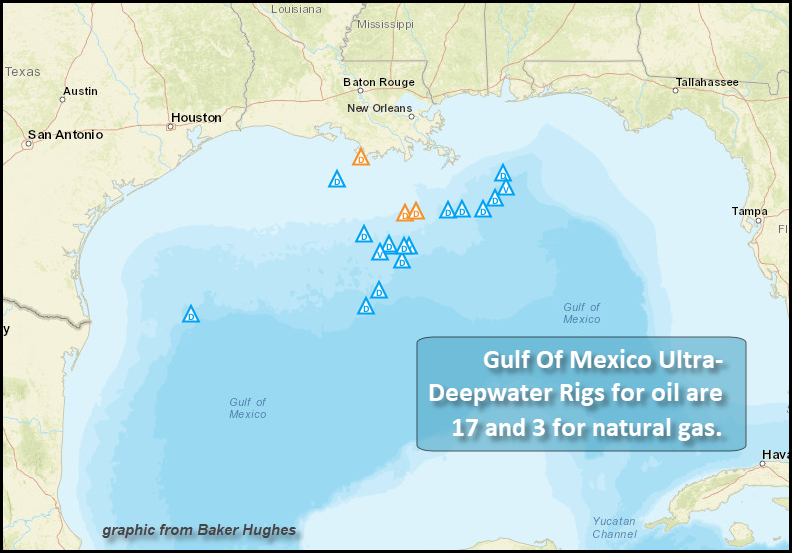
There are only a total of 20 rigs working in the Gulf of Mexico, with 17 drilling for oil and 3 for natural gas. The BLUE triangles represent rigs drilling for oil, and the ORANGE triangles are for natural gas. However, we must remember that one of those rigs leased to Chevron will be terminated next month. So, it will be down to 16 rigs. Regardless, the Gulf of Mexico ultra-deepwater oil drilling rig count is nearly two-thirds less than it was at its peak in 2013.
While Transocean still has a large backlog of drilling contracts, they could experience more terminations if the oil price takes a noise-dive. We must remember, the stock market and economy is being propped up by a great deal of Central Bank monetary printing and asset purchases. When the stock market finally experiences a 20-50% decline, this will take the oil price down with it... and BIG TIME.
We could easily see a $20-$30 oil price during a market melt-down. Certainly, this would destroy the already weakened ultra-deepwater drilling rig industry.
Lastly, the low EROI of ultra-deepwater oil production is not sustainable for an advanced society that needs something north of 10-12:1. My best guess is that ultra-deepwater oil EROI is likely closer to 3-5:1 when we factor in all indirect and direct costs. Compare that to the U.S. oil industry that was producing oil at a 100: 1 EROI in 1930. The amount of energy and technology that it took to produce oil in the early days was a fraction of what it is today.
Also, the notion that technology will solve our problems is one of the BIGGEST MYTHS we tell to ourselves. Technology doesn't increase the EROI of oil; it lowers it. Thus, the more technology that is used to drill and extract oil, the more the EROI of that oil is destroyed. While ultra-deepwater oil production has supplemented our total oil supply, I don't see it being a long-term sustainable industry... especially after the U.S. and world markets finally crack under the massive amount of debt and derivatives propping it up.
Check back for new articles and updates at the SRSrocco Report.